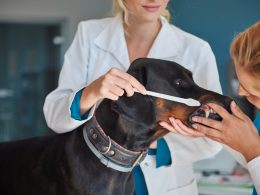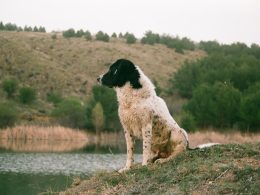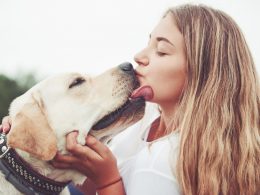The coat is one of the most striking features of a dog. You have seen a dog on the street and thought, “wow, how beautiful, what a shiny coat!”. Dogs have different coat types and color patterns, with variations in fur shape that can range from curly, straight, long and short, and even hairless. The natural color of the skin and coat of dogs depends on genetic traits and melanin. Melanin can be classified into two types responsible for the variation in hair tonality: Eumelanin, a variation in the tonality of black hairs, and pheomelanin, a variation in the yellow tonality. You may be interested in your dog’s coat and skin pigmentation simply out of aesthetic consideration and a health concern. If this is your case, you are in the right article.
Can Dog Skin Pigment Change?
The color change in puppies’ hair to adults is routine; usually, when dogs become adults, the color becomes darker. Kerry blue terrier dogs, for example, puppies are born with a black coat and reach adulthood around 18 months of age. The pigment of the skin and the coat of dogs can change as adults, making them lighter or darker. There are several reasons for this, and a veterinary diagnosis is essential, as this factor is usually linked to diseases. So stay tuned. If your dog is an adult and has any difference in the appearance of skin pigmentation, go to the vet, preferably a specialist in dermatology.
What Causes Pigment Loss In Dogs?
First, we need to understand that there are two types of differences in pigmentation, hyperpigmentation or melanoderma when there is the darkening of the skin and coat and hypopigmentation or leukoderma when lightening occurs. Both can occur on the skin and hair, but they can also have isolated effects, appearing only on the skin or only on the coat. Many dogs have a very high density of hair, and it is even difficult to observe the pigment of the skin, even if it is difficult always to try to watch separating the hair if there is variation in pigmentation.
Among the most common causes of pigmentation difference to dark tone are:
- Lentigo: black spots on the abdomen caused by genetics, resulting from increased melanin in the region. It doesn’t cause itching or change in skin texture, it’s just an aesthetic variation, but in rare cases, it can change to something more serious.
- Acanthosis Nigerians: common in Dachshund/Tecktel dogs. It may be due to genetics or allergies and mycoses. In this disease occurs the appearance of dark spots with a thicker texture in the groin regions.
- Hormonal changes: hormonal dysfunctions caused by gland malfunction can cause skin spots and changes in hair color.
- Tumors: some skin tumors such as melanomas, carcinomas, and fibromas can cause raised dark spots.
- Medications: some medications can cause hair color to change.
Among the causes of whitening are:
- Albinism: it is a strictly genetic and hereditary factor characterized by the lack of pigment throughout the body.
- Vitiligo: it also has a genetic and hereditary origin, causing spots without pigmentation on the body.
- Muzzle depigmentation: it has an unknown cause and occurs only in the muzzle region.
- Autoimmune diseases: some diseases, such as pemphigus and lupus, cause depigmentation.
- Nutritional deficiencies: unbalanced diets, and incredibly natural food without professional supervision, can cause depigmentation of the hair and coat due to a deficiency of zinc, copper, lysine, and vitamin B5.
How Can I Improve My Dog’s Pigment?
After the veterinarian makes the diagnosis, the indicated treatment will considerably improve the condition in a few days. But if your dog is healthy and you’re looking for alternatives just for aesthetics, there are options on the market for pet dyes that don’t cause any allergic reaction or toxicity.
Does The Sun Make Dogs’ Skin Darker?
Yes, the sun can cause dark spots on the body, so it is not recommended that the tours be taken during the sunniest hours of the day. It is also recommended to use sunscreen for dogs. Some color and pattern variations may be associated with disease and should only be cautiously reproduced by professional breeders. Check this coat variation:
Merle is a coat pattern with many variations! They are unusual, beautiful, and exotic. However, the main concern for any dog breeder should be health, temperament, and confirmation. A certain degree of knowledge must be had when breeding merle dogs to avoid health problems; therefore, merle dogs should only be used by experienced dog breeders. Merle randomly dilutes the Eumelaninin the coat to a lighter color, leaving some parts in the original color, causing a marbled effect. The spots can be any size and can be located on the dog. The edges of the spots can be jagged and “torn,” unlike the spots on a piebald dog. Merle is known to cause some health problems, mainly deafness and blindness, as well as sun sensitivity and higher rates of skin cancer. These problems are uncommon in heterozygous merles (Mm). They are more common in homozygous merles (MM).
For this reason, two merle dogs should not mate as a general rule, as this will likely result in some double merle puppies. There are exceptions, but we won’t go into that moment, as understanding depends on more advanced knowledge. Double merle dogs can be problematic because, in this case, it can cause a lack of pigment in certain vital areas – the eyes and inner ears. Most heterozygous merles have plenty of coloring because they still have an m (non-merle) allele to help them, but double merles often have large white areas where there is no pigmentation.














